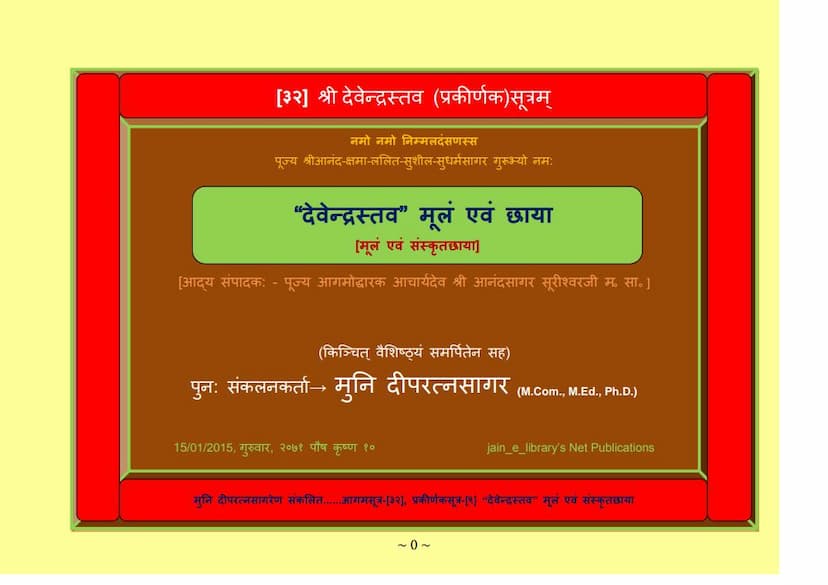Aagam 32 DEVENDRA STAV Moolam Evam Chhaayaa
Added to library: September 1, 2025
Loading image...

Summary
This document is the Devendra Stav, Prakirnakasutra #9, part of Agam 32, compiled and re-edited by Muni Deepratnasagar.
Key Features of this Publication:
- Original Work: The "Devendra Stav" is an ancient Jain text, originally compiled by Shruta Sthavira.
- First Edition: It was first published in 1927 (Vikram Samvat 1983) by the Agamoday Samiti, edited by the revered Agamoddharacharya Shri Anandasagar Surishwarji (also known as Sagaranaadsuri). This initial publication contained 10 Prakirnakas.
- Re-publications and Concerns: The author notes that subsequent republications by others often involved simply scanning the original, adding their own names and publishing house details, sometimes even omitting the original editor's and publisher's names.
- Muni Deepratnasagar's Effort: This new edition is presented by Muni Deepratnasagar as an effort to honor the original work and the reverence for Shri Sagaranaadsuri. His aim is to provide a more accessible and informative version.
- Enhanced Features:
- The original edited text by Shri Sagaranaadsuri is preserved.
- The Agam's name and the sutra/gatha numbers are placed at the top of each page for easy reference.
- A "Deep Anukram" (Deep Index) is provided, allowing users to navigate across all of Muni Deepratnasagar's Jain Agam publications (in various languages).
- A separate index is created for each study or chapter, facilitating easy access to specific topics.
- Footnotes are included to clarify specific subjects, original printing errors, or numbering discrepancies.
- Digital Presentation: This publication is presented as an "Internet Publication" by jain_e_library.org for wider and easier access globally. Plans for a printed version are also mentioned.
- Content of the "Devendra Stav": The text itself is a detailed exposition of the celestial beings residing in different realms of Jain cosmology, including:
- Bhavanpati (Territorial Deities): It describes the various types of Bhavanpati deities (Asuras, Nagas, Suparnas, Uddhikumaras, Vayukumaras, Vidyutkumaras, Dhanishthakumaras, and Agniskumaras), their leaders (Indras), the number of their respective abodes (bhavans), their cities, and their dwelling places.
- Vyantera (Sub-Territorial Beings): It lists the eight classes of Vyantera beings (Pishachas, Bhutas, Yakshas, Rakshasas, Kinnaras, Kimpurushas, Mahoragas, Gandharvas) and mentions their respective leaders and abodes.
- Jyotishka (Celestial Beings): It details the celestial bodies like Chandras (Moons), Suryas (Suns), Nakshatras (Stars), and Grahas (Planets), their numbers, locations, characteristics, and the distances and movements involved.
- Vaimanika (Sky-Dwelling Deities): It describes the celestial mansions (Vimanas) of the Vaimanika deities, categorizing them into Kalpas (realms like Saudharma, Ishana, Sanatkumara, Mahendra, Brahma, Lanta, Mahashukra, Sahasraara, Aanata, Pranata, Aarana, Achyuta), their respective sizes, the number of Vimanas in each Kalpa, their duration of stay (sthiti), their heights (uchchatva), their qualities (like colors, fragrances, tastes, touches), and their daily routines and lifespans. It also details the Graiveyaka and Anuttara Vimanas.
- Ishat Pragbhara Prithvi and Siddha Avastha: The text culminates in describing the realms of Ishat Pragbhara Prithvi and the state of Siddhas (liberated souls), their locations, their subtle forms, their perception (avadhi-jnana), their eternal bliss, and their characteristics.
- Focus on Numbers and Descriptions: The text is rich with numerical details about the number of heavens, mansions, beings, their lifespans, heights, distances, and qualities, providing a cosmological overview of the Jain universe.
In essence, this publication presents a detailed Jain cosmological treatise that elaborates on the various celestial abodes and beings, their characteristics, and their order within the universe, with a particular emphasis on the hierarchical structure and the divine rulers (Indras) of these realms. Muni Deepratnasagar's contribution is to make this ancient knowledge more accessible and well-indexed for modern readers.